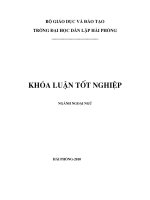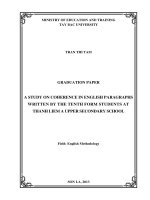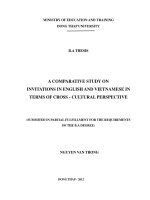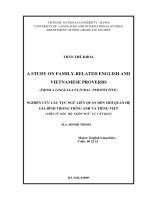a study on implicature in english and vietnamese funny stories ham ngon trong truyen cuoi tieng anh va tieng viet
Bạn đang xem bản rút gọn của tài liệu. Xem và tải ngay bản đầy đủ của tài liệu tại đây (37.52 KB, 5 trang )
1
VIETNAM NATIONAL UNIVERSITY- HANOI
UNIVERSITY OF LANGUAGES AND INTERNATIONAL STUDIES
FACULTY OF POST- GRADUATE STUDIES
NGUYỄN THỊ HỒNG NHUNG
A STUDY ON IMPLICATURE IN
ENGLISH AND VIETNAMESE FUNNY STORIES
(Hàm ngôn trong truyện cười tiếng Anh và tiếng Việt)
M.A Minor Programme Thesis
Field:
English Linguistics
Code:
60.22.15
Supervisor: M.A Đào Thu Trang
HANOI-2010
VIETNAM NATIONAL UNIVERSITY- HANOI
UNIVERSITY OF LANGUAGES AND INTERNATIONAL STUDIES
FACULTY OF POST- GRADUATE STUDIES
NGUYỄN THỊ HỒNG NHUNG
A STUDY ON IMPLICATURE IN
ENGLISH AND VIETNAMESE FUNNY STORIES
(Hàm ngôn trong truyện cười tiếng Anh và tiếng Việt)
M.A Minor Programme Thesis
Field:
English Linguistics
Code:
60.22.15
Supervisor: M.A Đào Thu Trang
HANOI-2010
3
TABLE OF CONTENTS
STATEMENT OF AUTHORSHIP………................................................................
i
ACKNOWLEDGEMENTS…………………………………………………………
ii
ABSTRACT…………………………………………………………………………
iii
LIST OF TABLE AND FIGURE…………………………………………………...
vi
PART A: INTRODUCTION………………………………………………………
1
1. Rationale………………………………………………………………………….
1
2. Aims of the Study………………………………………………………………...
2
3. Scope of the Study..................................................................................................
2
4. Method of the Study................................................................................................
2
5. Organization of the Study.......................................................................................
2
PART B: DEVELOPMENT....................................................................................
4
CHAPTER 1: THEORETICAL BACKGROUND................................................
4
1.1. Overview of Discourse Analysis..........................................................................
4
1.1.1. Definition of Discourse.....................................................................................
4
1.1.2. Discourse versus Text.......................................................................................
4
1.1.3. Discourse Analysis............................................................................................
5
1.1.4. Context in Discourse Analysis..........................................................................
6
1.2. Word Meaning.....................................................................................................
6
1.3. Sentence Meaning................................................................................................
7
1.4. Utterance Meaning...............................................................................................
8
1.5. Implicature...........................................................................................................
12
1.5.1. The Notion of Implicature.................................................................................
12
1.5.2. The Cooperative Principal and Maxims............................................................
13
1.5.2.1. The Maxim of Quantity..................................................................................
13
1.5.2.2. The Maxim of Quality....................................................................................
14
1.5.2.3. The Maxim of Relation..................................................................................
15
1.5.2.4. The Maxim of Manner...................................................................................
16
1.5.3. Non- Observance...............................................................................................
16
1.6. Overview of Funny Stories..................................................................................
17
CHAPTER 2: THE STUDY.....................................................................................
19
2.1. Research question................................................................................................
19
2.2. Data collection.....................................................................................................
19
2.3. Data Analysis.......................................................................................................
19
2.3.1. Maxim of Quantity............................................................................................
19
2.3.2. Maxim of Quality..............................................................................................
24
2.3.3. Maxim of Relation............................................................................................
27
2.3.4. Maxim of Manner.............................................................................................
30
2.4. Discussion............................................................................................................
34
2.4.1. Result and Discussion of the Result………………………………………......
34
2.4.2. Similarities........................................................................................................
35
2.4.3. Differences........................................................................................................
35
PART C: CONCLUSION........................................................................................
37
1. Major Findings........................................................................................................
37
2. Implications to Language Teaching and Learning..................................................
37
3. Limitation of the Study and Suggestions for Further Study...................................
40
REFERENCES..........................................................................................................
42
APPENDICES……………………………………………………………………...
I
APPENDIX 1: ENGLISH FUNNY STORIES...........................................................
I
APPENDIX 2: VIETNAMESE FUNNY STORIES..................................................
V
5
ABSTRACT
This thesis was written in an attempt to uncover the implicature in English and Vietnamese
funny stories in terms of maxims. The study is in three parts and the main part consists of
three chapters. The first gives literature reviews on semantics, pragmatics and discourse
issues, the second is about methodology and the last is findings and discussion.
To implement this study, the author investigates randomly 100 breakings of maxims
in English and 100 breakings of maxims in Vietnamese funny stories. The author collects
data by writing down dialogues where breakings of the four maxims occurred, mainly
violating and flouting. The author looks at which of the four – quality, quantity, relevance
and manner are broken in each story and which are broken most frequently. Furthermore, the
author looks at the reason to why and when the maxims are broken to create humor in funny
stories. As a result, the author draw out some similarities and differences between
implicature in English and Vietnamese funny stories in terms of maxims. Finally, the study
puts forward some implications for the English teaching and learning so that the learners of
English can understand make full use of advantages of funny stories to make English
learning less challenging.









